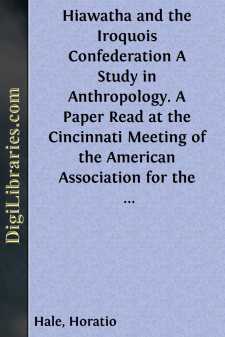Categories
- Antiques & Collectibles 13
- Architecture 36
- Art 48
- Bibles 22
- Biography & Autobiography 813
- Body, Mind & Spirit 142
- Business & Economics 28
- Children's Books 17
- Children's Fiction 14
- Computers 4
- Cooking 94
- Crafts & Hobbies 4
- Drama 346
- Education 46
- Family & Relationships 57
- Fiction 11829
- Games 19
- Gardening 17
- Health & Fitness 34
- History 1377
- House & Home 1
- Humor 147
- Juvenile Fiction 1873
- Juvenile Nonfiction 202
- Language Arts & Disciplines 88
- Law 16
- Literary Collections 686
- Literary Criticism 179
- Mathematics 13
- Medical 41
- Music 40
- Nature 179
- Non-Classifiable 1768
- Performing Arts 7
- Periodicals 1453
- Philosophy 64
- Photography 2
- Poetry 896
- Political Science 203
- Psychology 42
- Reference 154
- Religion 513
- Science 126
- Self-Help 84
- Social Science 81
- Sports & Recreation 34
- Study Aids 3
- Technology & Engineering 59
- Transportation 23
- Travel 463
- True Crime 29
Hiawatha and the Iroquois Confederation A Study in Anthropology. A Paper Read at the Cincinnati Meeting of the American Association for the Advancement of Science, in August, 1881, under the Title of "A Lawgiver of the Stone Age."
by: Horatio Hale
Categories:
Description:
Excerpt
A LAWGIVER OF THE STONE AGE. By HORATIO HALE, of Clinton, Ontario,
Canada.
What was the intellectual capacity of man when he made his first appearance upon the earth? Or, to speak with more scientific precision (as the question relates to material evidences), what were the mental powers of the people who fashioned the earliest stone implements, which are admitted to be the oldest remaining traces of our kind? As these people were low in the arts of life, were they also low in natural capacity? This is certainly one of the most important questions which the science of anthropology has yet to answer. Of late years the prevalent disposition has apparently been to answer it in the affirmative. Primitive man, we are to believe, had a feeble and narrow intellect, which in the progress of civilization has been gradually strengthened and enlarged. This conclusion is supposed to be in accordance with the development theory; and the distinguished author of that theory has seemed to favor this view. Yet, in fact, the development theory has nothing to do with the question. If we suppose that the existing and—so far as we know—the only species of man appeared upon the earth with the physical conformation and mental capacity which he retains at this day, we make merely the same supposition with regard to him that we make with regard to every other existing species of animal. How it was that this species came to exist is another question altogether.
Philologists regard it as an established fact that the first people who spoke an Aryan language were a tribe of barbarous nomads, who wandered in the highlands of central Asia. Those who have studied the earliest products of Aryan genius in the Vedas, the Zend-Avesta, and the Homeric songs, will be willing to admit that these wandering barbarians may have had minds capable of the highest efforts to which the human intellect is known to have attained. Yet if an irruption of Semitic or Turanian conquerors had swept that infant tribe from the earth, no trace of its existence beyond a few flint implements, and perhaps some fragments of pottery, would have remained to show that such a people had ever existed. Have we any reason to doubt that in the course of all the ages, in various parts of our globe, many tribes of men may have arisen and perished who were in natural capacity as far superior to the primitive Aryans as these were to the races who surrounded them? Under the law of the survival of the fittest, it is not the strongest that survive, but the strongest of those that are placed in the most favorable circumstances. On any calculation of probabilities, it will seem likely enough that among the numberless small societies of men that have appeared and vanished in primeval Asia and Europe, in Africa, Australia, America, and Polynesia, there may have been some at least equal, if not superior, in mental endowments, to that fortunate tribe of central Asia, whose posterity has come to be the dominant race of our time. Among their leaders may have been men qualified to rank with the most renowned heroes, exemplars, and teachers of the human race—with Moses and Buddha, with Confucius and Solon, with Numa, Charlemagne, and Alfred, or (to come down to recent times) with the greatest and wisest among the founders of the American Republic....



